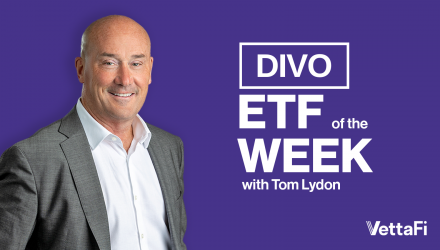VettaFi’s vice chairman Tom Lydon discussed the Amplify CWP Enhanced Dividend Income ETF (DIVO) on this week’s “ETF of the Week” podcast with Chuck Jaffe of “Money Life.”
DIVO seeks investment results that generally correspond to an existing strategy called the Enhanced Dividend Income Portfolio (EDIP). The strategy is managed by DIVO’s sub-adviser, Capital Wealth Planning (CWP).
The fund provides a dividend income strategy to shore up investors’ portfolios, generating monthly yields to reduce the bumps in the face of potential risks ahead. It’s a viable solution for income hunters, and in times of uncertainty, the need to generate monthly income becomes a priority. However, it’s also important to remain poised for any upcoming rally.
Investors can make a defensive play that can also provide a healthy monthly income stream potential. The size of income is often prioritized over-growth of income, resulting in longer-term issues. On the other hand, upside potential may be forfeited if investors are too dependent on bonds for their income.
The goal: seeking companies with a history of growing earnings and dividends combined with covered calls option premiums. Not every dividend payer is worth owning, but the thousands of companies show that the desire for income is ongoing. While fixed income products expose investors to interest rate risk, companies can increase dividends. Based on an average of all rolling 12-month periods since 1940, dividend growth has exceeded inflation by an average of 2.4% per year.
According to S&P Global, dividends have been responsible for 32% of the total return of the S&P 500 Index since 1926. Dividend and option income may provide lower share price volatility than the overall market during broad-based market declines. Investors can also combat inflation by owning companies with a history of growing their earnings and dividends, a characteristic of the ETF’s selection process.
Covered-Call Options Strategy
Adding a conservative covered-call writing strategy overlay has the potential to help drive total return. Writing covered calls on portfolio holdings can be another valuable income source. A covered call is an instrument sold by the stock owner in return for a share of future appreciation of the stock during a defined period.
It’s a conservative income strategy since there are two outcomes:
- The stock is sold at a higher price on the expiration date of the call option. The call writer keeps the option premium and the appreciation of the underlying stock up to the call (or strike) price.
- The stock never exceeds the strike price during the period up to expiration. If this happens, the call writer keeps the option premium and also keeps the stock in the portfolio.
Today’s heightened level of volatility could lead to higher premiums on a well-executed covered call strategy. The tactical approach to covered call writing seeks to enhance investment income whether markets go up, down, or sideways.
Amplify CWP Enhanced Dividend Income ETF
Actively managed funds are designed to provide investors with a high monthly income level on a risk-adjusted basis. They assemble a portfolio of quality, large-cap stocks with a history of dividends and earnings growth. They are screened and adjusted according to attributes, including market cap, management track record, earnings, cash flow, and return on equity.
A tactical covered-call writing strategy is implemented. With this, DIVO seeks to provide investors with a gross annual income of 2-3% from dividends and 2-4% from option premiums. It delivers a 4.86% 12-month yield, according to Morningstar. The top holdings include United Health Group, Chevron, McDonald’s, and Home Depot. The top sectors are healthcare, infotech, energy, financials, and consumer discretionary. The fund provides another layer of diversification through varying sector weights compared to the technology/consumer-heavy S&P 500.
Listen to the whole episode covering DIVO here:
For more news, information, and analysis, visit VettaFi | ETF Trends.

